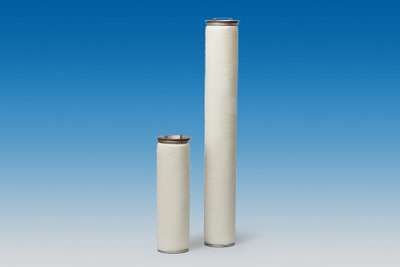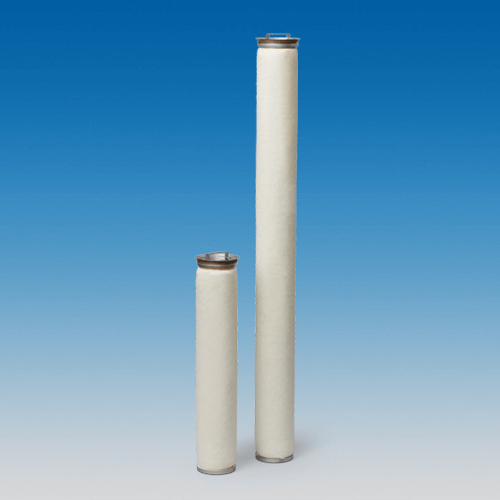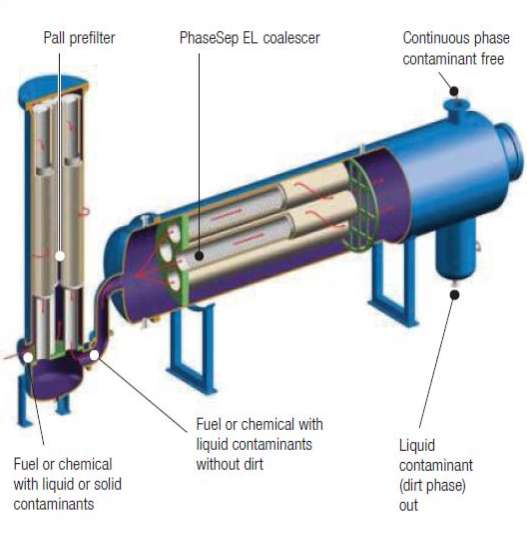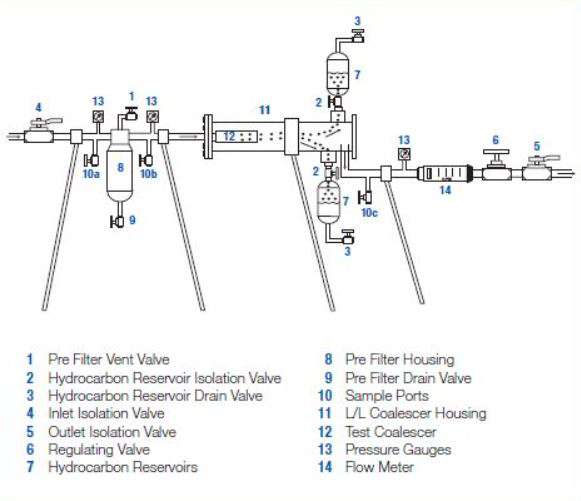PhaseSep EL Coalescer vs. ‘Original’ PhaseSep Coalescer
- Lower OPEX from longer pre-filter and coalescer life due to coarser ratings
- Directly retrofittable with PhaseSep coalescer
- Uses new medium specifically selected to yield desired performance in target applications
The PhaseSep EL system is typically a multiple-stage system, starting with prefiltration to remove particulate matter, followed by either a one-stage horizontal coalescer or two-stage integrated vertical coalescer/ separator stack to separate the two liquid phases. PhaseSep EL coalescers will remove oil and grease to a level of 20 ppmw, or free water to a level as low as 15 ppmv, and be effective over a wide range of conditions such as inlet liquid contaminant concentration as high as 0.1% and interfacial tension less than 10 dynes/cm1 . The PhaseSep EL coalescer system is available in two different housing configurations. Both configurations begin with a filtration stage to remove solid contaminants.
PhaseSep EL Coalescer - Horizontal Housing Configuration
In a horizontal housing, the liquid/liquid mixture enters the coalescing element and flows inside-to-outside, small liquid dispersed phase droplets suspended in the continuous phase come together, or coalesce, as the mixture moves through the PhaseSep EL coalescer. The large coalesced droplets of the dispersed phase separated by gravity in the horizontal housing and are removed. The size of the housing is a function of the flow rate, IFT, viscosity, and specific gravity of the liquids.
PhaseSep EL Coalescer/Separator Stack - Vertical Housing Configuration
The liquid/liquid mixture enters the coalescing element and flows inside-to-outside. Small liquid droplets suspended in the continuous phase come together, or coalesce, as the mixture moves through the coalescer medium.
Contaminant-free liquid and large droplets of the dispersed phase flow toward the separator located directly below the coalescer stage. Flowing is outside-to inside. The separator medium is hydrophobic preventing the aqueous phase from entering the separator. Only the non-aqueous continuous phase fluid flows through the separator. The two liquids are removed by separate drain connections.
Contaminant-free liquid and large droplets of the dispersed phase flow toward the separator located directly below the coalescer stage. Flow through the separator is outside-to-inside. The separator medium is hydrophobic and prevents the aqueous phase from entering the separator. Only the non-aqueous continuous phase fluid flows through the separator. The two liquids are removed by separate drain connections.
Table 1: Coalescer Selection Guide
| Process Condition |
Recommended Product |
| The dispersed phase fluid is aqueous and a horizontal vessel footprint is acceptable |
PhaseSep EL coalescer in a horizontal housing without separator |
| The dispersed phase fluid is oil and the continuous phase fluid is aqueous |
| The dispersed phase fluid is aqueous and minimal footprint is required |
PhaseSep EL coalescer/ separator stack in a vertical housing |
Figure 1. PhaseSep EL Liquid/Liquid Separation System with Coalescer in a Horizontal Housing with Prefilter (for removal of aqueous from hydrocarbon)
Figure 2. PhaseSep EL Liquid/Liquid Separation System with an Integrated Coalescer/Separator Stack in a Vertical Housing with a Prefilter








